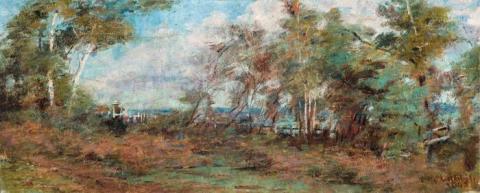BRIGHTON LANDSCAPE, 1905
Frederick McCubbin
oil on canvas
25.5 x 61.5 cm
signed and dated lower right: F. McCubbin / 1905
Mr W.R. Sedon, Melbourne, c.1952
Private collection, Melbourne
Deutscher Fine Art, Melbourne, 1982
Private collection, Melbourne
Frederick McCubbin Exhibition, To Mark the Centenary of The Artist's Birth in 1855, National Gallery of Victoria, 1955, cat. 22
Australian Colonial and Impressionist Paintings, Deutscher Fine Art, Melbourne, 22 March – 9 April 1982, cat. 33 (illus.)
The beginning of the century was a vintage period for Frederick McCubbin, his many masterly works including The Pioneer, 1904/5 (National Gallery of Victoria), Childhood Fancies, 1905 (private collection), and Lost, 1907 (again National Gallery of Victoria). He also painted a number of highly engaging smaller works of delightful fantasy, lyrical beauty and charm - What the Little Girl Saw in the Bush, 1904, (private collection), this painting Brighton Landscape of 1905, Wattle Glade, Macedon, 1907, (once in the distinguished collection of Sir Baldwin Spencer), and a number of others, including the Bendigo Art Gallery's Sylvan Glade, Macedon, 1906. Even before he made his eventful trip to England, his painting was revealing those qualities which we associate with the very best in his art, found as much in his paintings of the Macedon bush as in those of South Yarra, overlooking the river. Brighton, however, had a special, earlier role, inspiring such works as Brighton Beach, 1896 with its Corotesque ti-trees (Mildura Arts Centre), On the Wallaby Track, 1896 (Art Gallery of New South Wales), and A Winter Evening, 1897 (National Gallery of Victoria).
Frederick McCubbin and his growing family lived in New Street, Brighton from 1895 to 1900, before returning to city living. In those days Brighton was an outer Melbourne suburb, of orchards, open country, and an appealing beach. McCubbin was not alone in being attracted to the area. Fellow residents included artists such as John Longstaff, John Mather, and Alexander Colquhoun. For McCubbin at Brighton the landscape as a special subject in its own right began to exert a greater appeal. Sentimental narratives of the passing pioneers were gradually yielding to pleasing transcripts of the bush, as in Brighton Landscape. He also moved away from that heightened verisimilitude which sought exactitude of rendition, favouring a more painterly and atmospheric style in which he excelled, bringing out the poetical side of the Australian bush. His handling became more impressionistic, with trees, scrub and sky enveloped in an almost aqueous atmosphere. This, in turn, was enlivened by the subtle play of lights and darks achieved largely through the broader strokes of his colour-laden brush. The measure of how well McCubbin succeeded is provided in the painting's provenance, having been long in the personal collection of the artist's dealer, W.R. Sedon of Melbourne's Sedon Galleries. This was endorsed years later by curator, Dr Ursula Hoff's selection of the painting for inclusion in the 1955 exhibition at the National Gallery of Victoria, arranged to mark the centenary of the artist's birth.
DAVID THOMAS
